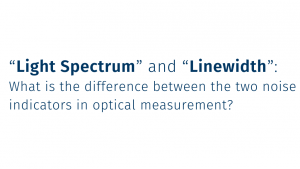In today's society, laser technology plays an important role in a wide variety of fields.
For example, lasers are used in applications as diverse as telecommunications, medicine, manufacturing, and scientific research. However, in order to maximize the performance of lasers in these applications, their characteristics must be accurately understood and evaluated. In the field of telecommunications, “ line width” is one of the most important factors. Line width refers to the width of a laser's light frequency spectrum, which is used to evaluate the purity and stability of the laser.
This article will discuss laser line width in detail. We will introduce the basic definition and types of line width, as well as methods for measuring laser line width, such as delayed interferometry, digital coherent receivers, and light-FM-to-electric-FM conversion.
Through this article, we hope that you will gain a better understanding of line width and be able to use laser line width measurement equipment more effectively.
Table of Contents
- What is laser line width?
- Why is laser line width evaluation necessary?
- 4 types of laser line width measurement methods
- SYCATUS Optical Noise Analyzer “A0040A”
- SYCATUS Laser Line Width Measurement System “A0020A”
- FAQ 1-3
- Conclusion: Basic Knowledge of Light Measurement: What is “Laser light width”?
What is laser line width?
Caused by fluctuations in the light frequency of the laser
Laser line width is one of the key characteristics of the frequency spread of laser light. An ideal laser should oscillate at a single wavelength (or frequency), but actual lasers vary the frequency of light over time and spread over a certain range due to various factors. The width of this spread is called the “line width”.
Line width is an important indicator for evaluating the purity and stability of a laser and has a direct impact on its performance in a wide variety of applications such as communications and measurement.
Fluctuations in the light frequency of a laser are also dependent on the laser's output characteristics and environmental conditions. To minimize this, the design of the laser and the operating environment must be optimized. For example, temperature control, vibration control, and power supply stabilization are known to be effective measures. In addition, optimized design techniques for the laser resonator structure itself can also contribute to laser line width reduction.
The unit for evaluating laser spectrum purity is “Hz”
Laser line width is expressed in units of “Hz” (hertz). This unit indicates the range of variation in the frequency of the laser beam and is an important indicator for evaluating its purity. It generally refers to the full width at half maximum (FWHM*) of the spectrum of the laser's electric field, which is the difference between the frequencies at the two ends of the spectrum line with half the intensity of the maximum intensity. The wider the line width, the wider the spectrum (the frequency of the laser beam fluctuates greatly), and conversely, the narrower this value is, the more concentrated the spectrum is and the higher the purity of the spectrum (the frequency of the laser beam is stable).
*FWHM is also an important parameter in laser design and manufacturing processes. For example, the line width must be optimized by adjusting the laser resonator design, temperature control, and drive current.
Why is laser line width evaluation necessary?
The evaluation and control of laser line widths is an essential element in the development and application of laser technology. It is especially important for investigating the performance in the field of telecommunications, precision measurement, and medical equipment.
For example, in fiber optic communications, especially in digital coherent communication systems, the narrower the laser line width, the better the signal quality and the higher the speed and quality of data transmission. Also, in precision measurement, the use of a laser with a narrower line width allows for more precise measurements.
This is due to the requirement for low phase noise and high frequency stability.
On the other hand, wide line widths are sometimes required in fields such as medicine and material processing, which require energy delivery over a wide wavelength range.
A common method for measuring and evaluating laser line width is to use a light spectrum analyzer to directly observe the spectrum of the laser output light and measure the frequency difference at half the peak intensity of the spectrum. This measurement enables appropriate evaluation of the laser's characteristics and its suitability for the application.
However, the frequency resolution of most light spectrum analyzers is 600 MHz or higher, and narrower line widths cannot be measured. In recent years, evaluation of line widths below 10 kHz has become necessary in the fields of fiber optic communications and precision measurement.
4 types of laser line width measurement methods
In order to accurately measure laser line width, it is essential to use the appropriate instruments and methods. Let's take a look at some typical measurement instruments and their features.
1. Delayed interferometry
The delayed interferometer method is a line width measurement method that was commonly used in the past. In this method, a laser beam is divided into two beams, one of which is delayed and then interfered with again. The beat signal caused by the interference is observed by an electrical spectrum analyzer, and the line width of the laser can be determined from the spread of the spectrum. The merits of this method include its simple configuration and the fact that no prior adjustment is required. This method provides higher resolution than light spectrum analyzers.
Advantages
- Relatively simple configuration
- No need for pre-adjustment
Disadvantages
- Measurement results depend on delay time
- Detailed line width information is not provided
- Light frequency fluctuations in lower bands are dominant
- Not suitable for applications such as digital coherent communication, FMCW LiDAR, etc., where line width evaluation of a specific band of light frequency variation is required

2. Light FM - light AM conversion method
In light FM - light AM conversion method, the frequency variation (FM) of laser light is converted to intensity variation (AM) by using a light filter or other element whose transmittance depends on the light wavelength (light frequency). Line width is evaluated by measuring the intensity of the converted light signal using a light detector and an electrical spectrum analyzer. This method is applicable to a wide bandwidth of light frequency variations.
Advantages
- Intuitive and easy to understand
Disadvantages
- Requires prior adjustment of the operating point of the light filter
- Low reproducibility
- Difficult to accurately calibrate the wavelength dependence of light filter transmittance
- Insufficient dynamic range due to inability to ensure wavelength linearity of light filter transmittance over a wide range
- Because the light FM- light AM conversion efficiency depends on light intensity, fluctuations in light intensity make it impossible to measure correctly
- Light intensity noise is overlaid on the measurement results
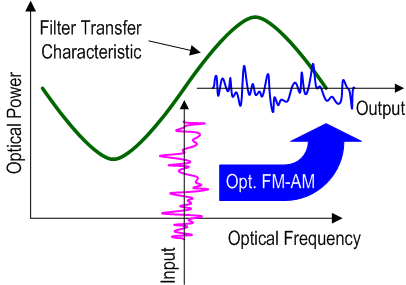
3. Digital coherent receiver method
The digital coherent receiver method is a system that applies digital coherent communication devices. In this method, a digital coherent receiver is used to sample the intensity and phase of laser light, and the line width is obtained by extracting the spectrum of light frequency variation from the data. The advantage of the digital coherent receiver method is that sampling is performed in real time, enabling efficient measurement. It is also applicable to a wide bandwidth of light frequency variation.
Advantages
- Efficient measurement
- Wide measurement bandwidth
- Less susceptible to light power fluctuations
Disadvantages
- Line width of local light source is overlaid on the result
- Influence of quantization noise is large
- Requires pre-setting of light wavelength channel
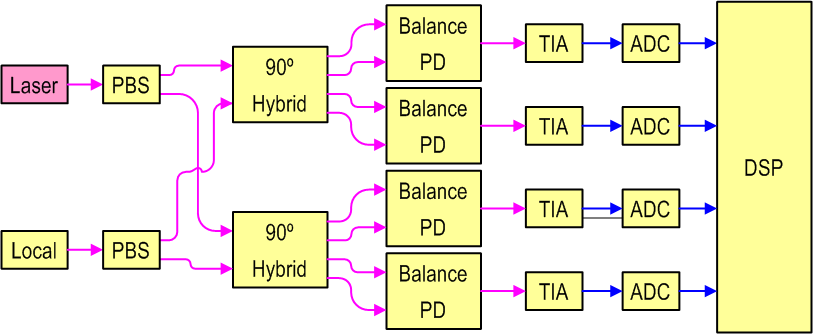
4. Light FM - electrical FM conversion method
The light FM - electric FM conversion method uses a special delay interferometer to convert light frequency fluctuations (FM) into electric frequency fluctuations for measurement. The electrical frequency fluctuations are analyzed using an electrical spectrum analyzer to calculate line widths. The advantage of this method is its wide dynamic range and high measurement accuracy. Since no prior adjustment of the operating point or light wavelength is required, the measurement can be performed efficiently.
Advantages
- No need for pre-adjustment
- Wide dynamic range
- Low noise floor
- High repeatability as the only parameter that determines measurement accuracy is the interferometer delay time
- Not affected by light power fluctuations
Disadvantages
- Limited measurement bandwidth
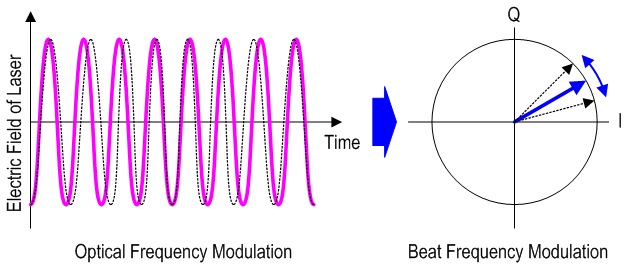
SYCATUS Optical Noise Analyzer “A0040A”
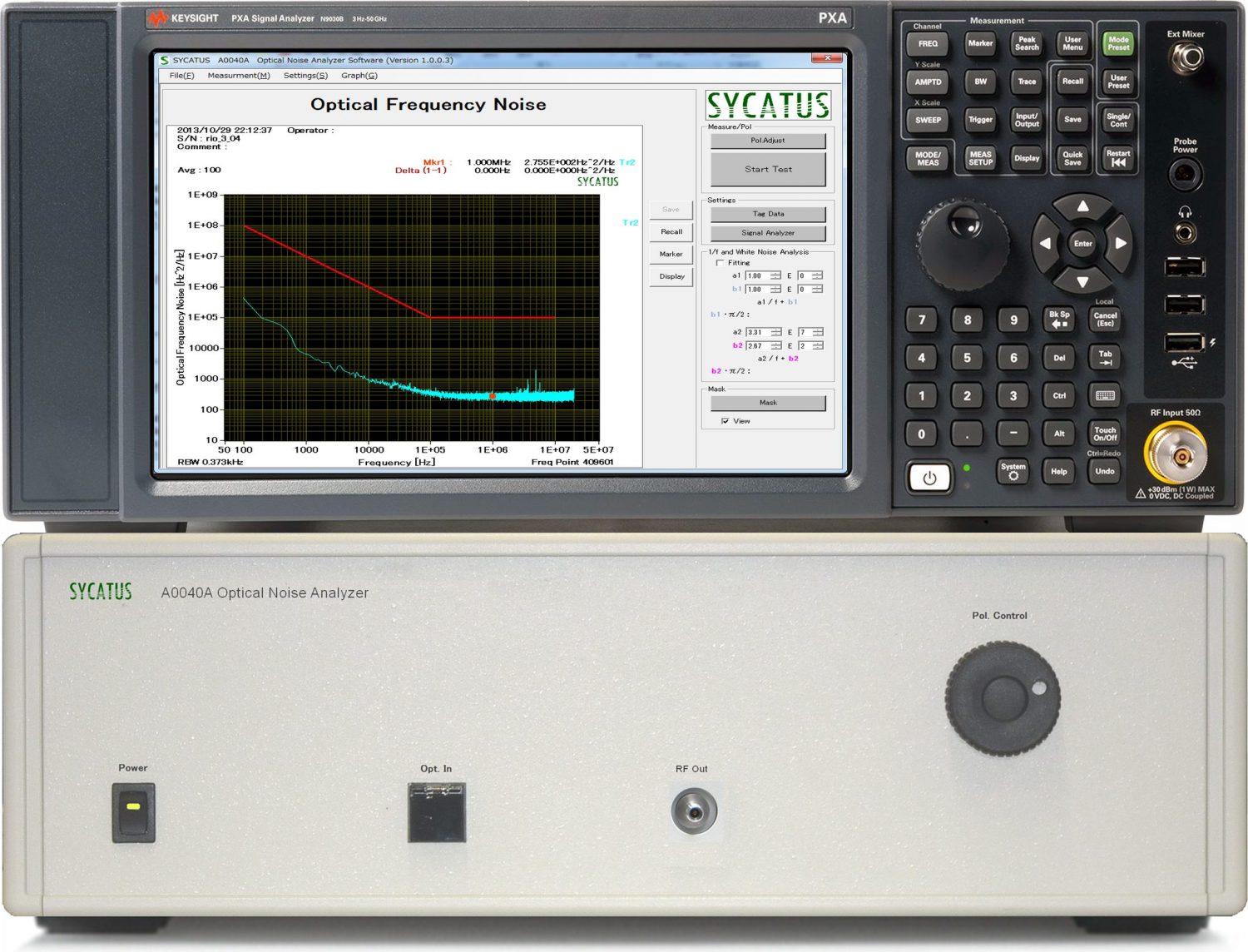
SYCATUS' A0040A Optical Noise Analyzer is the industry's first solution to evaluate laser line width as a power spectral density of light frequency noise using a light FM- electric- FM conversion method.
Its wide dynamic range enables correct measurements even when light frequency dither is used for ITLA. It analyzes the 1/f noise, white noise, and Lorentz line width of lasers required for digital coherent transmission systems. Since no prior adjustment is required, measurement throughput can be increased. The measurement bandwidth, which is considered a challenging issue, is also extended to 255 MHz. Since a reference laser source is not required, the line width is not affected by the reference laser source.
SYCATUS Laser Line Width Measurement System “A0020A”

SYCATUS' laser line width measurement system “A0020A” is a measurement system for laser line width evaluation based on the conventional delay interferometer method.
Laser line width evaluation is essential for the development, manufacturing, and quality control of lasers used in optical communications.
Line width can be easily measured by combining a high-sensitivity, low-noise light test set and Keysight Technologies' signal analyzer.
FAQ 1-3
1. What are the key points for accurate light measurement in brief?
In order to perform accurate light measurement, it is first necessary to select the optimum measurement device and means of measurement according to the characteristics of the measurement target.
Another key point is to perform measurements in an environment with minimal changes in temperature and humidity to ensure the stability of the measurement environment. This will minimize errors due to external factors.
In addition, it is recommended that the measurement equipment itself be calibrated on a regular basis. Accurate calibration improves the reliability of measurement results.
2. What is the relationship between line width and resolution?
Line width is evaluated by spectrum, and resolution, or Resolution Band Width (RBW), is an important factor in spectrum evaluation.
The resolution bandwidth is determined by the sampling method of the spectrum. For line width measurements, the resolution bandwidth must be sufficiently small compared to the line width. In general, the resolution bandwidth should be less than 1/10 of the line width to be measured.
3. What is the difference between the SYCATUS Optical Noise Analyzer “A0040A” and conventional products?
SYCATUS' A0040A line width measuring instrument is superior to conventional products in the following respects.
First, the advanced technology of the light-FM-to-electric-FM conversion method enables measurement of minute line widths and more accurate data.
Also, operability has been improved, with a user-friendly interface. This makes it easy to operate even without specialized knowledge, which is a major advantage.
Furthermore, the measurement speed has also been improved. Compared to conventional products, measurement time is less than 1 second in high-speed measurement mode, allowing for more efficient measurement work. Therefore, its performance is especially beneficial in situations where large amounts of data are handled or real-time measurement is required.
Conclusion: Basic Knowledge of Light Measurement: What is “Laser light width”?
In this article, we have described the basics of laser line width, its importance, measurement methods, and state-of-the-art measurement systems. Laser line width is a weighty indicator of optical quality, and accurate line width evaluation is required especially in the fields of digital coherent communication and coherent sensing.
In addition, there are several methods for measuring laser line width, each of which has its own specific advantages. By selecting the appropriate measurement method, more accurate data can be obtained, contributing to the success of research and product development.
SYCATUS' A0040A Optical noise analyzer and A0020A laser line width measurement system are tools that combine accuracy, ease of use, and the latest technology.
By improving your understanding of laser line width and proactively incorporating new technologies into your development and research, you will be able to improve the accuracy of your light measurements.
Feel free to contact us.
As a pioneer in measurement in the field of optical communications and optical sensing, SYCATUS has been providing integrated hardware and software systems for measurement for over 20 years.
We will continue to provide innovative light measurement technologies developed on the basis of expertise, uniqueness, and accuracy to the world.
We also provide expert advice on a wide range of light measurement questions and concerns regarding the installation of system equipment.
Our experts are available to help you solve your light measurement problems.


